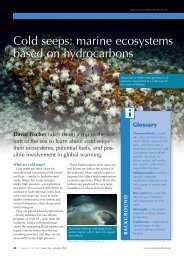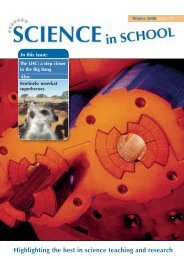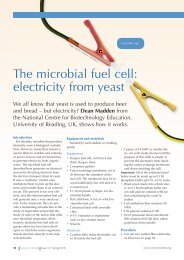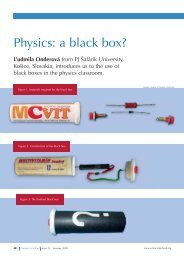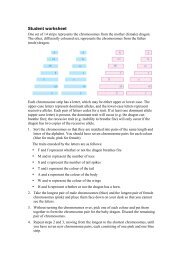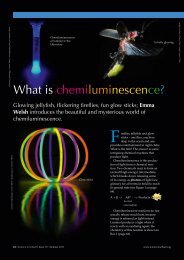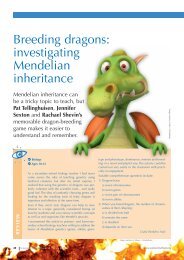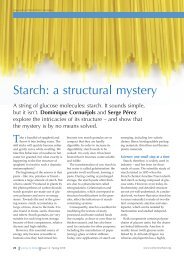Download Issue 14 as PDF [5.4 MB] - Science in School
Download Issue 14 as PDF [5.4 MB] - Science in School
Download Issue 14 as PDF [5.4 MB] - Science in School
You also want an ePaper? Increase the reach of your titles
YUMPU automatically turns print PDFs into web optimized ePapers that Google loves.
Image<br />
courtesy of<br />
Èlia Benito Gutierrez<br />
Amphioxus<br />
1 cm<br />
<strong>in</strong>terest<strong>in</strong>g is that the ancient ancestor<br />
that amphioxus represents w<strong>as</strong> a k<strong>in</strong>d<br />
of m<strong>in</strong>imalist or ‘stem’ vertebrate.”<br />
Although officially an <strong>in</strong>vertebrate,<br />
that amphioxus h<strong>as</strong> a lot <strong>in</strong> common<br />
with backboned vertebrates. It h<strong>as</strong> a<br />
hollow nerve cord runn<strong>in</strong>g down its<br />
back, like our sp<strong>in</strong>al cord, and next to<br />
this a notochord, a stiff but flexible<br />
rod that supports the body, serv<strong>in</strong>g <strong>as</strong><br />
a k<strong>in</strong>d of primitive backbone. As<br />
embryos, we also have a notochord, a<br />
remnant from our <strong>in</strong>vertebrate p<strong>as</strong>t,<br />
but just like the pharyngeal arches,<br />
ours is broken up and re-used – to<br />
make the disks that lie between the<br />
vertebrae. “As the closest liv<strong>in</strong>g relative<br />
of the ancestor of all vertebrates,<br />
amphioxus gives us a rare glimpse of<br />
how our evolutionary ancestors are<br />
likely to have looked,” Èlia says. And<br />
really, the chances of such an evolutionarily<br />
important fossil species<br />
be<strong>in</strong>g alive today must be phenomenally<br />
slim.<br />
So how did the vertebrates evolve<br />
from these amphioxus-like ancestors?<br />
Of course, cartilage and bone evolution<br />
w<strong>as</strong> very important, but the transition<br />
from <strong>in</strong>vertebrate to vertebrate<br />
<strong>in</strong>volved more than a backbone. It<br />
w<strong>as</strong> also a matter of lifestyle choice,<br />
particularly feed<strong>in</strong>g. Where<strong>as</strong> creatures<br />
like amphioxus sat on the<br />
seabed, wait<strong>in</strong>g for food to come to<br />
them, the early vertebrates evolved a<br />
new strategy: predation. They started<br />
to evolve the means to actively f<strong>in</strong>d<br />
food, requir<strong>in</strong>g a whole raft of novel<br />
<strong>in</strong>novations, body parts and skills.<br />
Key to these w<strong>as</strong> the evolution of a<br />
new head.<br />
It might seem obvious, but to<br />
actively feed yourself, you first have<br />
to f<strong>in</strong>d your food. For this, you need<br />
sophisticated sensory organs to see,<br />
smell, t<strong>as</strong>te and hear it (although our<br />
<strong>in</strong>vertebrate ancestors had sensory<br />
cells or organs, the early vertebrates<br />
evolved paired organs, like our eyes,<br />
allow<strong>in</strong>g them to sense the world <strong>in</strong><br />
three dimensions). Where better to<br />
evolve these new, food-f<strong>in</strong>d<strong>in</strong>g tools<br />
and the bra<strong>in</strong> they’re wired up to than<br />
next to your mouth? These <strong>in</strong>novations,<br />
<strong>in</strong> turn, broadened the menu,<br />
and, for most vertebrates, the pursuit<br />
of less digestible diets resulted <strong>in</strong> the<br />
evolution of a jaw with teeth to bite<br />
and chew food before it reaches the<br />
gut.<br />
Key to both the development and<br />
evolution of the head is a tissue called<br />
‘neural crest’ – special cells orig<strong>in</strong>at<strong>in</strong>g<br />
from the same tissue that makes<br />
our bra<strong>in</strong> and sp<strong>in</strong>al cord. Once<br />
formed, these cells beg<strong>in</strong> to migrate<br />
all over the body. The f<strong>in</strong>al dest<strong>in</strong>ation<br />
of many is the head, where they<br />
make connective tissue, muscle, sk<strong>in</strong>,<br />
facial nerves, bones and cartilage,<br />
provid<strong>in</strong>g support crucial to the<br />
development of the eyes and the t<strong>as</strong>te<br />
and smell receptors of the mouth and<br />
nose. Neural crest cells also contribute<br />
(via the pharyngeal arches) to the<br />
jawbones, teeth, and the t<strong>in</strong>y bones of<br />
the middle ear, essential for the evolution<br />
of hear<strong>in</strong>g.<br />
As its name suggests (‘amphis’<br />
means ‘both’ and ‘oxys’ means<br />
‘sharp’; so ‘sharp at both ends’),<br />
amphioxus doesn’t have much of a<br />
head. Crucially, neither does it have<br />
neural crest, where<strong>as</strong> all vertebrates<br />
do. There is some evidence though<br />
that migrat<strong>in</strong>g cells a little like primitive<br />
neural crest exist <strong>in</strong> amphioxus<br />
and <strong>in</strong> tunicates (sea squirts), another<br />
<strong>in</strong>vertebrate group related to the<br />
ancestral vertebrate. By study<strong>in</strong>g<br />
these cells, Èlia hopes to understand<br />
how neural crest, and by extension,<br />
the head, evolved.<br />
S<strong>in</strong>ce the completion of the<br />
amphioxus genome sequence <strong>in</strong> 2008,<br />
amphioxus research h<strong>as</strong> really come<br />
of age. Scientists like Èlia can now<br />
work out how the stem vertebrate<br />
genome would have looked.<br />
Comparisons with vertebrate<br />
genomes, <strong>in</strong>clud<strong>in</strong>g human, show<br />
remarkable similarity. “We now know<br />
that amphioxus h<strong>as</strong> all the same<br />
important gene families that vertebrates<br />
have,” expla<strong>in</strong>s Èlia. “All the<br />
b<strong>as</strong>ic build<strong>in</strong>g blocks needed to make<br />
a vertebrate are present. So you could<br />
<strong>as</strong>k: why doesn’t amphioxus develop<br />
like a vertebrate?” The likely answer<br />
to this also lies <strong>in</strong> the genome. Unlike<br />
18 <strong>Science</strong> <strong>in</strong> <strong>School</strong> <strong>Issue</strong> <strong>14</strong> : Spr<strong>in</strong>g 2010<br />
www.science<strong>in</strong>school.org


![Download Issue 14 as PDF [5.4 MB] - Science in School](https://img.yumpu.com/26126440/20/500x640/download-issue-14-as-pdf-54-mb-science-in-school.jpg)


